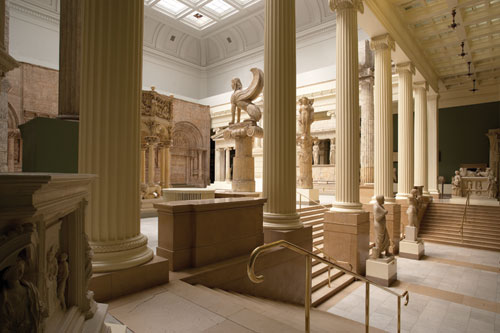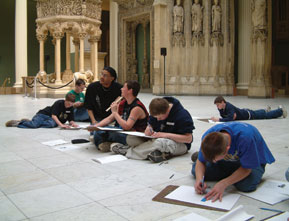 |
||
Finding Classic OaklandTo emphasize the historical significance of the Hall of Architecture, the museum’s education department is planning an architectural scavenger hunt to help students connect On a Grand Scale to local historic buildings.
Students will tour the exhibition with a docent, participate in a variety of hands-on activities, and then head out into the streets of Oakland, guided by staff from the Pittsburgh History & Landmarks Foundation, to look for real-life examples of the classically inspired structures.
Just steps away from the exhibition, students will discover that the Oakland neighborhood takes much of its classic Beaux-Arts character from the work of architect Henry Hornbostel, who designed the original buildings of Carnegie Mellon University, Mellon Institute, the University of Pittsburgh’s Webster Hall, Rodef Shalom, and the Soldiers and Sailors Military Museum and Memorial. The columns and pyramidal roof of Soldiers and Sailors derive from the Mausoleum at Halicarnassus. A cast of a 40-foot fragment of this lost “Wonder of the World,” known only through drawings based on archaeologists’ discoveries, stands in the Hall of Architecture.
In addition, two University of Pittsburgh landmarks were inspired by the 12th- to 16th-century Gothic style. The Cathedral of Learning and Heinz Memorial Chapel, with its pointed spires, were designed by 20th-century architect Charles Z. Klauder. They show the influence of works in the Hall of Architecture, particularly the Cathedral of Saint Andre, Bordeaux.
|
Art On a Grand Scale
Long a window onto the world for generations of Pittsburghers, Carnegie Museum of Art’s Hall of Architecture and its collection of architectural casts—one of the few remaining in the world—is also an international treasure. In honor of the hall’s hundredth anniversary, a new exhibition opening September 22 traces its rise to star status.  Beginning in late September, Mattie Schloetzer of Carnegie Museum of Art’s Heinz Architectural Center, hopes that visitors to the Hall of Architecture—that sky-lit, cathedral-like space that takes the museum’s patrons into antiquity—will step back to really appreciate Lorenzo Ghiberti’s Baptistry Doors. And the Mausoleum of Halicarnassus, Nicola Pisano’s Pulpit, and the Porch of the Maidens from the Acropolis, too. All four might make great names for your son’s garage band. But these life-sized replicas of some of the world’s most famous monuments are artifacts not of pop culture, but rather of the ornate, classical styles that became a hallmark of the Beaux-Arts era. The Hall of Architecture houses one of the few remaining collections of architectural casts in the world, not to mention the largest in the western hemisphere, and its masterpieces stand exactly where they’ve been for a century, in the heart of Carnegie Museums’ 1907 addition. Its 100-year anniversary is high time to give the collection the accolades it deserves. A revealing exhibition opening in the Heinz Architectural Center (HAC) on September 22, called On a Grand Scale: The Hall of Architecture at 100, will do exactly that, and more. Organized by Schloetzer, the exhibition explores the art of cast-making and chronicles how the world’s third-largest cast collection came to be in Pittsburgh. “This hall and its collection of casts are truly exceptional,” says Schloetzer, the enthusiastic young curator of the exhibition that runs through January 27, 2008, “and we wanted to honor that. Pittsburgh has something most places don’t: a big, extraordinary collection of architectural casts. Other museums are finally pulling their casts out of basements. Here, our collection is intact, displayed in a grand room specifically made for it.” In fact, plaster casts fell out of museum favor in the 20th century. “Casts became something people were embarrassed about,” Schloetzer explains. Casts were acquired mainly due to the lack of money available for original works of art. In the late 19th and early 20th centuries, American museums were still in their infancy and were cash-poor. But as American museums gained greater access to European masterworks and began augmenting their collections with modern art, they began discarding their plaster casts, viewing them as little more than pallid replicas of authentic rarities. Fortunately, Carnegie Museum of Art didn’t follow fashion. Only The Best for PittsburghWhen Andrew Carnegie visited the World’s Columbian Exposition in Chicago in 1893, he was struck by the fine architectural casts on display. Examples of three of them—the Choragic Monument of Lysicrates from Athens, the north transept portal of the Cathedral of St. Andre at Bordeaux, France, and the central portal of the west facade of the Abbey Church of St. Gilles in Gard, France—still stand in the great Hall of Architecture today.In an 1894 essay, the philanthropist wrote glowingly of the potential of casts to educate Americans of a wide range of cultures, and he pursued with typical vigor the acquisition of the finest possible examples for his Pittsburgh museum. As early as 1895, he and Director of Fine Arts John Beatty met with staff at the Metropolitan Museum of Art in New York City to request permission to produce casts from the Met’s molds for Pittsburgh. The Met director’s stiffly worded rejection “defined what Carnegie Museums’ architectural collection would not be,” notes Schloetzer. As a complement to Carnegie’s own wish list, the museum surveyed the premier American architects of the day, to get their must-have recommendations. Fifteen architects—including the renowned Charles McKim, Daniel H. Burnham, and Cass Gilbert—responded with a unanimous top choice: the French Benedictine Abbey Church of St. Gilles. Four other monuments received a majority vote and they, too, were purchased for Carnegie’s collection: the Porch of the Maidens and the Choragic Monument of Lysicrates in Athens, the north transept of the Cathedral of Bordeaux, and the Baptistry Doors in Florence, known as the Gates of Paradise, by Ghiberti. Copies of the architects’ letters will be on display in the exhibition for visitors to read. When Copies Were KingIn the last decade, cast collections have enjoyed renewed interest. Because the buildings from which the casts were made no longer exist in their original condition, the cast is a unique and invaluable record of the building. At the very least, comparing a cast to a still-standing original reveals a lot about the effect of more than 100 years of pollution. In most cases, the casts are in far better shape than the buildings themselves.Carnegie went to great lengths to develop his own, unique casts and preferred them to be poured directly from molds of the original buildings; his insistence about the process ensured that although they were reproductions, they were produced with high-quality craftsmanship. On a Grand Scale highlights that point with a focus on the hugely ambitious and expensive custom cast of the west facade of St. Gilles. The 38-foot-high, 74-foot-long cast, its plaster carefully tinted to match the original, dominates the southern portion of the Hall of Architecture. Carnegie Museums paid 2,000 gold francs, about $80,000 in current U.S. dollars, to the town of Gard for permission to make the huge cast of the porch of the 12th-century Romanesque church. Craftsmen had to make thousands of casts from piece molds and then pack them into crates. It took three separate trans-Atlantic voyages to transport the replica to Pittsburgh. Reassembled on-site by two French craftsmen, the cast was constructed over a period of more than eighteen months. Once made, piece molds could be re-used to create dozens of replicas, and cast-making, which began with the Greeks in the 4th century BCE, became a popular side business for some museums (though not Carnegie Museum of Art) at the turn of the century. On a Grand Scale suggests the wide range of offerings available from the British Museum, the Metropolitan Museum of Art, and even private companies with a display of catalogs that the directors of new American museums could browse for ready-made additions to their collections. Casts, especially sculptural fragments, were priced as low as $1, while copies from more labor-intensive architectural molds might have cost considerably more. Carnegie Museum’s cast of the Porch of the Maidens, for example, was purchased for about $25,000 in current U.S. dollars from the École des Beaux-Arts, the School of Fine Arts in Paris. Practice Makes Architects For decades, these replicas of some of the world’s most famous buildings have inspired countless young students in the Museum of Art’s drawing classes. But art enthusiasts weren’t alone in their admiration of the Hall of Architecture’s wonders. For decades, these replicas of some of the world’s most famous buildings have inspired countless young students in the Museum of Art’s drawing classes. But art enthusiasts weren’t alone in their admiration of the Hall of Architecture’s wonders.In the early 20th century, apprentices in skilled trades such as plumbing, engineering, and carpentry were encouraged to become proficient at drawing. Six rare drawing books from Penn State University’s library collection will be on view to show how prevalent drawing education was during this era. In this same spirit, Carnegie’s collection provided a free opportunity for anyone with a sketchbook to perch for hours in the Hall of Architecture. The practice is still honored in the hall today by university art and architecture students and younger enthusiasts in Museum of Art classes and camps. “In the hall, students get to see architectural details at their authentic scale,” says Charles Rosenblum, an adjunct professor at Carnegie Mellon University and architecture critic. “It’s a method of representation that books or the Internet can’t duplicate.” Tracy Myers agrees. “While the casts are not original objects, they are irreplaceable, and they have inherent aesthetic and historical value,” says the Museum of Art’s curator of architecture, noting that when other museums disposed of their casts due to space constraints and a change in taste, Pittsburgh was conservative and kept its collection intact. The opening of HAC in 1993 largely refocused attention on one of the Carnegie’s historic strengths: the art of the building. Already planning the future care of the hall, this past July Myers and Objects Conservator Michael Belman oversaw an engineering and conservation survey of the casts that assessed their structural integrity and overall physical condition. Supported by a $50,000 planning grant from The Heinz Endowments, additional work is already underway to develop a long-range plan so that the Hall of Architecture can awe and inspire visitors for another century. “Even today, most of us won’t get to the Acropolis or St. Gilles,” adds Myers. “This collection gives people an opportunity to experience something they might otherwise never see. Part of the long-term plan is to develop new interpretive tools to engage visitors and invigorate their experience of the hall.” Cast collections are coming back into favor “for the exact reasons they were established in the first place,” says Vivian Zoë, who oversees a large cast collection at the Slater Memorial Museum at the Norwich Free Academy in Connecticut. “Wealthy, well-traveled people like Andrew Carnegie and William Slater felt that just exposing people to these things would improve the viewers—they didn’t even have to read the interpretive labels to get the benefit. And when you enter the Hall of Architecture, you want to fall to your knees—wow! I want to live there,” she jokes. “It uplifts me. It does exactly what Carnegie wanted.” |
|
Inside Out · 100 Years Ago · The Real Deal · Hidden Treasure · Adding More Andy · Giant Steps Toward Building the Future · Director's Note · NewsWorthy · Now Showing · Face Time: Ron Wertz · About Town: Summer Sleuthing · First Person: Tracing the Making of a Collection · Artistic License: Dissecting Art · Science & Nature: Mind Games · Another Look: The Warhol's Film & Video Collection · Then & Now: Body Language
 |
Copyright © 2017 CARNEGIE Magazine. All rights reserved. |
